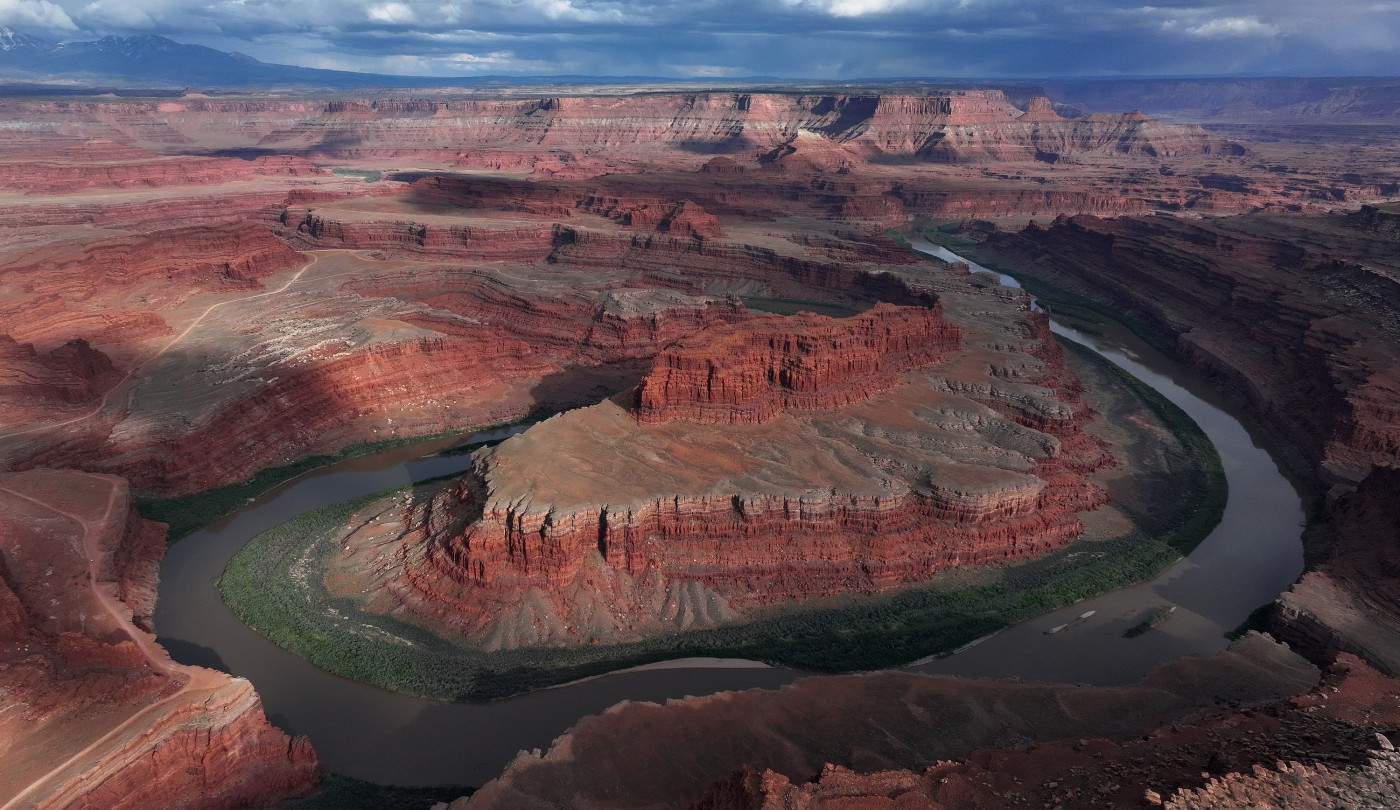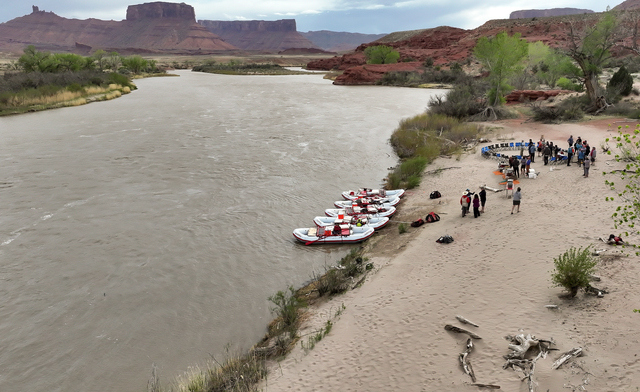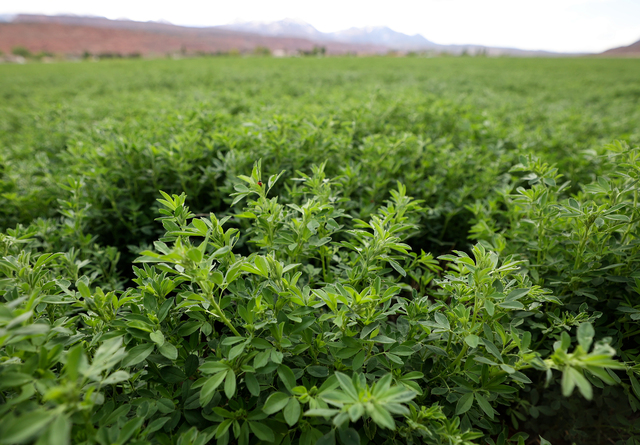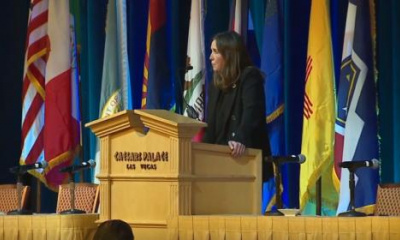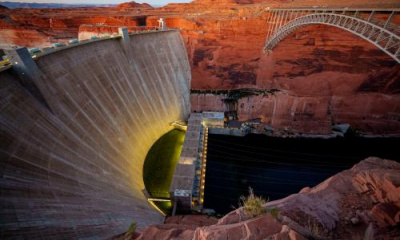New media collaborative seeks answers, solutions for the hardest working river in the West
Here in a canyon northeast of Moab, it is difficult to fully understand or appreciate the power of this wild, rugged river that is alternately a quiet slow-moving force of nature and then roiling with whitecaps.
As soon as you think you have a grasp on the complexity of the Colorado River, it winks at you and changes, winding this way, winding another way, catching the sun one moment and reflecting the clouds in another instance.
Officially, for 102 years, power brokers in the West have tried to harness this 1,450-mile long river that serves seven states, more than two dozen Native American tribes and the country of Mexico.
In 1922, the Colorado River Compact was formed as a way to allocate the water of this river and to stop the brewing political fights over its resources. It was a way to keep Congress from meddling and hold the federal government at bay, but like the river itself — the agreement is complicated and still a source of tension and strain as the river shrinks from drought and diversions.
In a rapidly growing West buckling from development amid an arid landscape, the Colorado River is this finite resource that can’t continue to be managed status quo or in a static fashion.
Journalists and water experts make a stop while rafting the Moab Daily section of the Colorado River with Holiday River Expeditions during a kickoff event for the Colorado River Collaborative in Grand County on Thursday, April 25, 2024. The kickoff event was sponsored by the Utah State University Janet Quinney Lawson Institute for Land, Water and Air and The Water Desk. | Kristin Murphy, Deseret News
Why the Colorado River matters
The award-winning Great Salt Lake Collaborative is expanding to focus on the Colorado River.
This new initiative is made up of 11 Utah newsrooms that have agreed to report on the river, its tributaries and destinations together.
As a solutions journalism initiative, collaborative stories will also explain what can be done to adapt to the new realities facing this troubled river, what actions are being taken and why.
In Moab over two days in late April, journalists heard from experts, traded ideas and were treated to a rafting trip — to get up front and personal with the river itself.
The expanded scope of this reporting was made possible with a founding gift from Utah State University’s Janet Quinney Lawson Institute for Land, Water and Air — but all editorial decisions are made independently by member news organizations in accordance with their respective editorial policies.
“No one can stand in the river at the same time,” and have the same experience, explained Zach Renstrom, general manager of the Washington County Water Conservancy District.
“We have to change.”
As states wrangle for water and the U.S. Bureau of Reclamation looms with new federal management mandates ahead of a 2026 operating guideline, everyone comes from a point of vulnerability. Will there be enough water and what if there isn’t?
“This is not a quick ship to turn around,” said Burdette Barker, a civil and environmental engineer at Utah State University, talking about the tension between agriculture and water use in the basin.
The Colorado River irrigates 5.5 million acres of land in the seven basin states: Utah, Colorado, Arizona, Wyoming, New Mexico, Nevada and California.
Of the land that is irrigated in Utah, 50% of that is devoted to alfalfa — a highly controversial crop because it is grown in the “desert,” sucks up water and many believe the majority of the crop is exported overseas.
In reality, Barker said less than 20% of that Utah crop goes to foreign countries, but instead is used for local feed for livestock — dairy, beef cattle, sheep and horses.
Alfalfa grows near Moab in Grand County on Thursday, April 25, 2024. | Kristin Murphy, Deseret News
“We grow some of the best alfalfa in the world, which is weird,” said Brian Steed, executive director of the Janet Quinney Lawson Institute of Land, Water and Air at USU.
Utah gets just shy of 30% of its water from the Colorado River due to complicated and highly expensive transbasin diversions, funneling the water from eastern Utah to the Wasatch Front via the Central Utah Project or the Provo River project. About two-thirds of the drinking water in Salt Lake County comes from the Colorado River.
So chances are if you turn on the tap, you are drinking some of that river water or if you are irrigating farmland in the Uintah Basin or Green River region, the Colorado River is your source.
The Colorado River is the source of 15 dams along its system. The nation’s two largest man-made reservoirs — Lake Mead and Lake Powell — are a huge straw. Lake Powell is the savings account for the Upper Basin, which is tasked with delivering 7.5 million acre-feet of water per year to the Lower Basin.
But what gets sucked out of Lake Powell goes downstream to Lake Mead. Both have “bathtub” rings that tell the tale of better water years, when they were a much stronger version of themselves and operating to meet the needs of 40 million users.
Glen Canyon Dam at Lake Powell, for example, uses eight generators that help meet the electrical needs of the West’s rapidly growing population. With a total capacity of 1,320 megawatts, Glen Canyon produces around five billion kilowatt-hours of hydroelectric power annually which is distributed by the Western Area Power Administration to Wyoming, Utah, Colorado, New Mexico, Arizona, Nevada and Nebraska. In the immediate vicinity, without the dam, the lights in Page would go dark.
A megawatt for perspective is enough energy to power up roughly a thousand homes.
In an operational move in 2023 that sent some shock waves, the U.S. Bureau of Reclamation authorized additional releases of 1.6 million acre-feet of water from Flaming Gorge and Blue Mesa reservoirs from the Upper Basin to save power generation at Lake Powell.
The bureau is on deadline to make changes. Both basins have come up with plans to save and conserve water.
But Gene Shawcroft, the Upper Colorado River commissioner, said that ultimately, basing available water on “modeling” and forecasts can no longer be the playbook on which states, tribes and Mexico rely. It needs to be based on actual water in the system.
“You understand that there is a situation that if your check going in is less than your expenses coming out, pretty soon the bank calls and says you need to go find another bank. And that’s exactly what’s happened in this system,” Shawcroft said.
The collaborative understands that the Colorado River has made that phone call. Will we answer?

